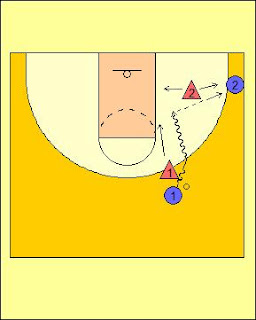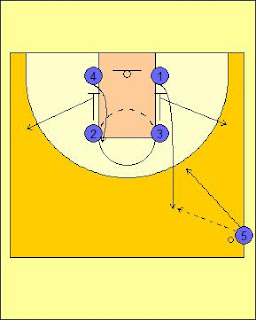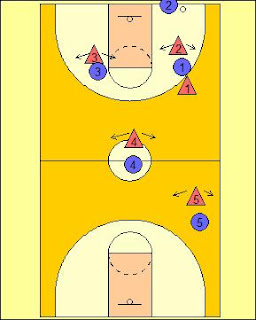You'd be hard pressed to find a college team in the country that executes its offense as well as Duke does. Coach Mike Krzyzewski has been running his 3-out 2-in motion offense for many years now and with the talent he's been able to bring in over the last couple of decades he has the national championships to show for it. The offense is one that we use and in many ways is similar to the hi-lo systems used by Bill Self of Kansas.
What you'll notice is that Duke's motion offense is so simple. It's effectiveness relies on the players within the system. Coach Krzyzewski has had some great forwards and guards in the past and they have executed it so well. Duke uses it on both man and zone defenses and while it may be mostly looked upon as a post-based offense, a lot of perimeter action can be run out of it.
Setup:As mentioned, this is a 3-out 2-in motion offense. If you plan on running the offense for your team, I would recommend that you have a couple of really well-rounded posts that can score effectively both with their back against the net and face-up. If you have perimeter players that can make shots, that will be another huge bonus but not mandatory. Below is the basic setup of the offense,

3-2 setup with both posts playing down low and each perimeter player occupying a spot. O1 passes to O2 on the wing and screens away for O3. O4 (ball-side post) sets a cross-screen for O5. Now, if the defense decides to front O5 (ball-side post), then O4 will come out to the ball-side elbow. If the defense decides to play behind O5, then O4 will occupy the weak-side elbow.
A side point, if the defense deny's the wing pass to O2, then simply do a dribble handoff or have O1 dribble to the wing.
Straight up Post entry:This is always option #1 as taught by Coack K. The most ideal situation is where the defense decides to play behind O5.

Since O5 is a dominant post player, we are confident that if O5 can get a good post-entry pass, 1-on-1, O5 should have a good look with a drop step, middle hook, or any variety of post moves to score. Duke has had excellent post players in the past such as Carlos Boozer, Shelden Williams and Josh McRoberts. If you have posts like them, you definitely want to get them the ball in a 1-on-1 situation to score.
Fronting the Post:Now if the defense decides they want to front O5. O4 will flash ball-side elbow instead off of the initial cross screen.

The ball is passed into O4 who then looks for O5 who has hopefully sealed X5 outside and should be an easy basket or even an and1 play. We've seen that play with Duke many times before.
Penetration Option:Now, normally, the offense will look to reverse the ball around to the other side if neither the post-entry or hi-low options are available and the motion continues on the other side of the court with O5 and O4 executing a simple X-cut or dive-fill. But this is a great counter play that Duke runs on occasion if the defense is overloaded on the ball-side or both O4 and O5 are being fronted.

O4 sets a ball-screen and O2 penetrates sideways into the lane. O5 flashes to the other block while the initial screen by O4 is being set, O3 and O1 spread and fill weak-side, O4 will roll off the pick to the ball-side block.
Once O2 reaches the free-throw line, there are 3 options. O2 can pull up for the mid-range (JJ Reddick took advantage of this beautifully), pass to O5 if X5 comes to help up top, or hit O4 on the roll off the pick.
Summary:Duke has been running this offense for years, yet it never gets old and they continue to win. If you have the players, specifically the forwards to run it, this is a great motion offense to use. Even against a
2-3 zone, O4 can get into the middle and exploit the zone there. I didn't show the perimeter weak side option, but the skip pass off the flare screen is also a great option. The beauty of the offense is its simplicity, coach K has very few rules with it and really allows his best players to be his best players.
If you're looking for more video instruction from Coach Krzyzewski,
I recommend Coach K's DVD on post-play development as that is a key component of the 3-out 2-in motion. I have Coack Krzyzewski notes, so be sure to check out the
X's and O's Basketball Forum and take a look at what I have.







































